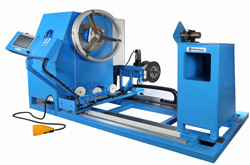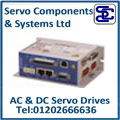
Posted to News on 2nd Oct 2015, 15:07
Coil winding machine features state-of-the-art control systems
Whitelegg Machines has just shipped a machine that will be used to wind body scanner coils for a Korean multinational company. This is the first machine of its type on which Whitelegg has installed state-of-the-art servo-controlled axes and a touchscreen HMI.

Whitelegg Machines has over 80 years' experience in designing, manufacturing and supplying equipment to the wire processing and electrical industries, exporting machines to customers worldwide. In general terms, the company's products fall into four groups: wire forming machinery; electric motor repair, rewinding and testing equipment; electrical safety test instruments; and coil winding machines. Always striving to provide customers with the best product at a cost-effective price, the company continues to develop its standard machines and also supplies one-offs and special-purpose machines when requested.
Recently the company shipped the latest iteration of its large coil winding machine, which will be used to wind body scanner coils for a Korean multinational company. Unlike previous large coil winders from Whitelegg Machines, this latest version benefits from servo-controlled axes, together with an intuitive touchscreen graphical user interface and a PLC with custom software for controlling the overall process. For the end user, these features translate into the following benefits:
- monitor and maintain a constant tension in the material being wound
- layer wind the material very accurately
- layer control for spooling and de-spooling
- programmable winding with an onboard memory for storing winding programs
- Data logging for each winding so that the number of turns, pitch and winding tension can all be recorded
Coil winding machine experience
Whitelegg developed and manufactured the first MRI (body scanner) winding machines in the world in 1982. This then-new technology was developed at Oxford University, which lead to locally formed companies producing the first full body scanners in the world. Eventually half a dozen companies were spawned from the initial manufacturer in and around Oxford, all of whom were supplied by Whitelegg. Oxford Magnet Technology became the first volume manufacturer and was supplied with over a dozen machines by Whitelegg. Oxford Magnet agreed to licence this technology to other medical equipment manufacturers, resulting in Whitelegg receiving machine orders from GE of the USA, Siemens in Germany and Furakaiwa in Japan.
The first body scanner was built in a concrete bunker outside Oxford, as it was feared that the magnetic fields could have been harmful to humans. In the event, the results have only been beneficial!
Oxford Magnet Technology was purchased by Siemens some years ago, since when, Whitelegg has designed and manufactured a special-purpose machine for winding small coils from special materials, with sophisticated tension control.

An integral de-spooler is servo-controlled and operates in conjunction with the servo-driven main rotation axis and the tensioning pulley, with a load meter providing the necessary feedback for the tension control system. All of the servo motors and servo drives are Lenze products, and FMS Force Measuring Systems provided the tension control load meter (comprising a load cell and amplifier). A further servo motor controls the axial movement of the de-spooler as each turn of wire is laid down adjacent to the previous turn.

The use of state-of-the-art servos and a specially developed HMI and control program offers clear benefits for end users. Interestingly, Whitelegg Machines says it can upgrade existing large coil winding machines - whether from Whitelegg or another manufacturer - so that the benefits can be enjoyed more widely by end users seeking better process control for coil winding. In some cases this work would be carried out at Whitelegg's factory in Surrey, but other machines may be suitable for the upgrade to be retrofitted at the customer's premises.
Follow the links to find out more about Whitelegg Machines, coil winders and to contact Whitelegg.















